Massive pick-up trucks are quickly becoming yet another American habit Australians are adopting with enthusiasm.
2025 Toyota Tundra Platinum review
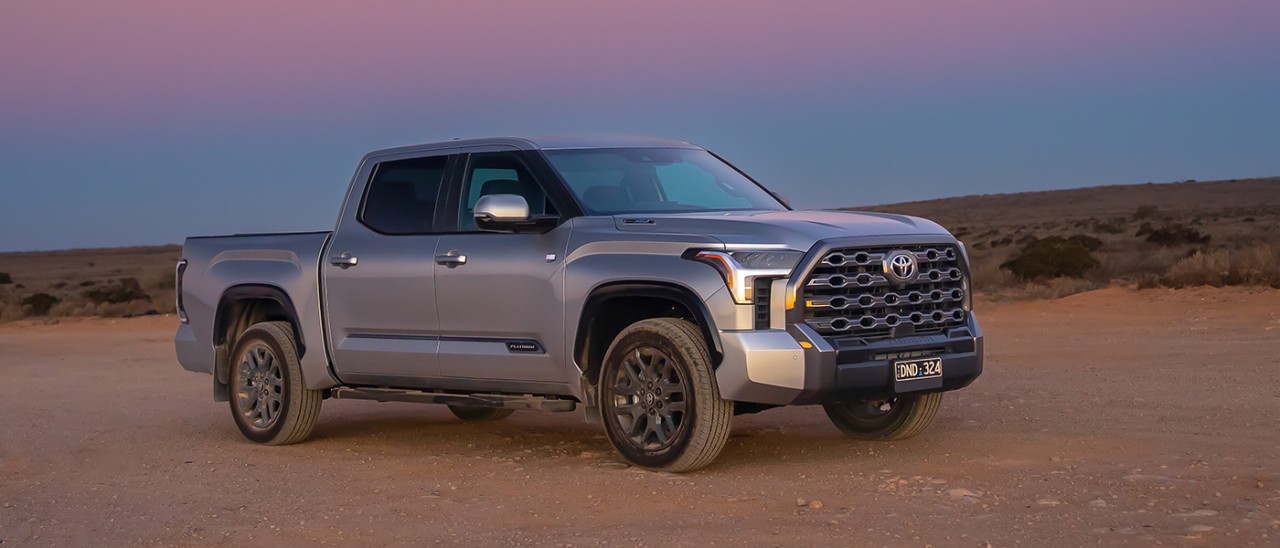
The 2025 Toyota Tundra Platinum aims to set a new standard in large utes, with a commanding presence and equally commanding price tag. But while it gobbles up the open roads of the Nullabor, does this behemoth warrant a place in the urban environment?
The Toyota Tundra is the latest in a series of US-sourced full-size pick-up trucks to arrive in Australia in a cohort that includes the Chevrolet Silverado, Ford F-150 and RAM Trucks. Originally available through an exclusive leasing arrangement direct from Toyota, the 2025 Toyota Tundra is now available to all buyers as long as you have a similarly sized wallet – the flagship Platinum model is now available for a luxury car price tag of over $170,000 plus on-road costs.
Offering 4500kg braked towing capacity when equipped with the relevant gear, the Tundra makes a case for a heavy-duty towing truck, whether for tradies looking for more capacity than a standard dual-cab or leisure seekers wanting to haul a caravan. But with the impressive 2026 Ford Ranger Super Duty confirmed for launch soon, with the same bulked-up towing capacity in a smaller, more street-friendly package, is the Tundra just too much truck?
Read More: The best cars for towing a caravan
On this page
- How much does a Toyota Tundra Platinum cost?
- Toyota Tundra Platinum exterior design
- What is the Toyota Tundra Platinum like inside?
- Is the Toyota Tundra Platinum good to drive?
- What safety features does the Toyota Tundra Platinum have?
- How does the Toyota Tundra Platinum compare?
- Should I buy a Toyota Tundra Platinum?
How much does a Toyota Tundra Platinum cost?
The 2025 Toyota Tundra Platinum costs $172,990 plus on-road costs. It's not cheap, but if you want to save a few dollars, you could head to the Toyota Tundra Limited that misses out on some of the creature comforts and finishes of the Platinum, but will still set you back $155,990 plus ORCs. American muscle does not come cheap.
For the eye-watering price you do at least get a largely capable truck loaded with gear. The Tundra boasts a powerful hybrid system, pairing a 3.5-litre twin-turbo V6 petrol engine with an electric motor, for a combined 326kW of power and a very healthy 790Nm of torque.
Key features include 20-inch black alloy wheels, a panoramic roof, heated and ventilated front and rear seats with front massage function, and a 14-inch touchscreen display with wireless Apple CarPlay. There's also plenty of space as the sheer size of the Toyota Tundra Platinum, which measures 5955mm long and 2040mm wide, translates to plenty of room for five, plus a tray which will hold all the gear.
Toyota Tundra Platinum exterior design
The exterior design of the Toyota Tundra Platinum is best described as bold, featuring a dominant, chrome-plated mesh-style front grille flanked by T-shaped LED headlight clusters, and distinct 20-inch alloy wheels highlighted by flared wheel-arches. An active front spoiler deploys and retracts to improve airflow or increase ground clearance.
The rear is equally assured, with large vertical LED tail-lights and a robust bumper incorporating an integrated step for easier tub access. It’s undeniably American in its styling, a look that must resonate with many Australian ute enthusiasts as over 10,000 drivers bought a supersized light commercial ute in 2024.
More: Australia's best utes
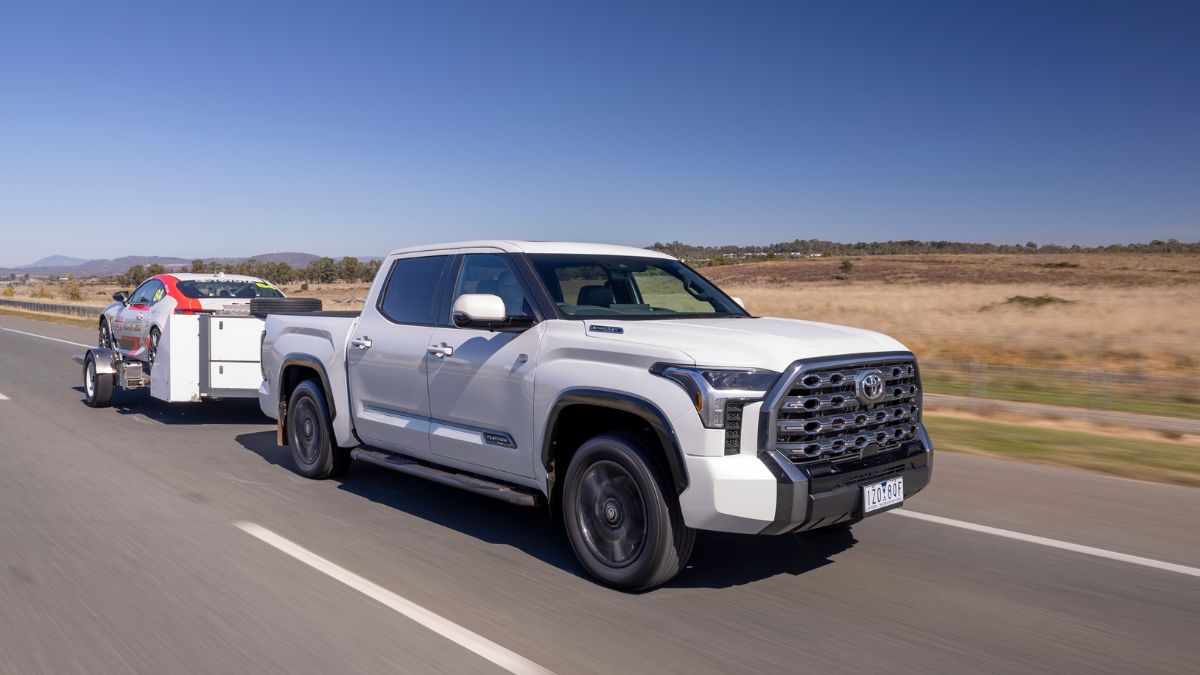
The Toyota Tundra Platinum has a hefty braked towing capacity of 4500kg.
What is the Toyota Tundra Platinum like inside?
The Toyota Tundra Platinum bridges the world of utility and comfort. That's to say, while the seat upholstery is well finished and the Platinum gains leather-accented upholstery, this vehicle is clearly built for practicality so it doesn't feel as overtly luxe as the price tag might imply.
It's a bit of a step up into the cabin, so you'll need to use the side step and the handles to get in – the feel is not unlike mounting a horse – but once inside, the cockpit is as bold and robust as the exterior and delivers a commanding driving position. A massive 14-inch touchscreen infotainment system dominates the dash, providing wireless Apple CarPlay and wired Android Auto.
It also houses an essential 360-degree camera which is crucial for seeing around the vehicle when reverse parking. The infotainment system is enhanced by a decent 12-speaker JBL premium sound system which helps to fill the hours spent driving the massive Nullabor plan of our road test route.
One of the telltale signs that this is a vehicle designed for the left-hand drive market and converted to RHD in Australia is the position of several key controls on the left side of the infotainment screen, requiring a long stretch across the cabin to operate them.
A 12.3-inch digital instrument cluster and 10.9-inch head-up display deliver information in the driver's line of sight. Storage is abundant, with a sizeable centre console, numerous cupholders, and under-seat stowage in the rear.
For long-distance driving, the heated and ventilated front seats with massage function are essential to deliver a comfortable driving experience, while rear passengers in the Platinum not only get commodious accommodation but the two outward seats also receive heating and ventilation – a nice-to-have when starting a desert drive in single-figure temperatures.
More: Understanding inbuilt device and car screen laws in Victoria
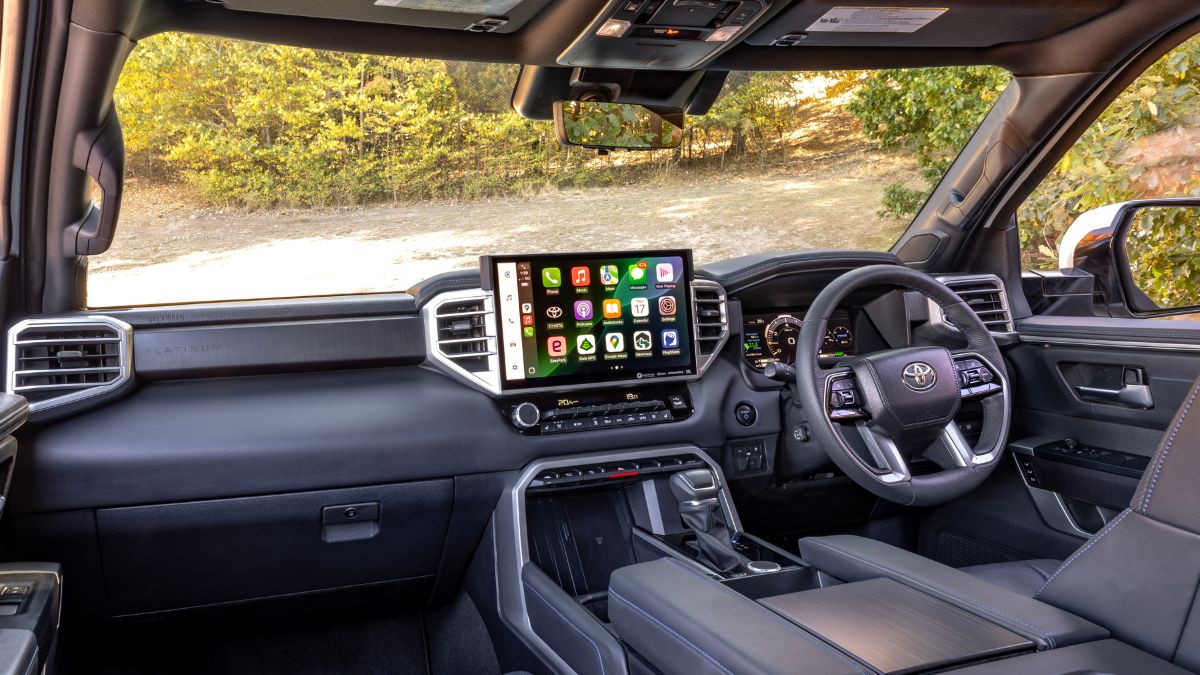
A commanding vehicle like the Toyota Tundra demands a commanding cockpit.
Is the Toyota Tundra Platinum good to drive?
Our first drive of the new Toyota Tundra Platinum took place on the open roads of the Nullabor Plain. With posted speed limits of 110km/h, and no deviation off some of the longest and straightest strips of tarmac in Australia, it was a gimme of a test drive for a big truck.
Here, the Tundra is at an appropriate scale and feels almost diminutive in comparison with our iconic Aussie road trains, and with no tight supermarket car parks to tackle, no opportunity to see just how many car parking spots the Tundra takes up.
The Tundra's higher driving position means vision down the long straights was excellent. This was a set-the-cruise-control-and-forge-ahead kind of test drive.
The 3.5-litre V6 hybrid delivers the requisite power delivery for overtaking slow-moving vehicles, and piped-in engine noise boosts its growl on acceleration, but application of the loud pedal feels like a guilty pleasure. Fuel economy for the cruise was registered at 14L/100km and filling up the tank an expensive exercise. The Tundra carries its fuel in a 122L tank and filling it with 95 RON premium unleaded wlil set you back around $240, depending on the fuel price.
The ride on smooth tarmac was relatively settled given there was no weight in the rear. With selectable four-wheel drive, the Tundra can drive the rear wheels only when in 2H, or all four wheels when 4H is selected. 4WD-L is also available for off-road driving.
The Tundra is equipped with a multilink suspension that enhances its on-road manners, and also contributes to its driving capability off-road. While our test drive didn't trouble the Tundra with complex four-wheel driving, we did punt it through some dunes, shifting into 4WD-L through thick sand.
The Tundra's long chassis means it's far from nimble through tight-ish corners, so serious off-roaders will find the Toyota LandCruiser more capable.
One niggle we did notice on test was how tricky it was to shift back into 2H once back on tarmac. It took a fair bit of effort and negotiating with the vehicle before normal progress could be resumed – a decent-sized fly in the $200,000 ointment.
More: The best Australian road trips to tick off your Bucket List
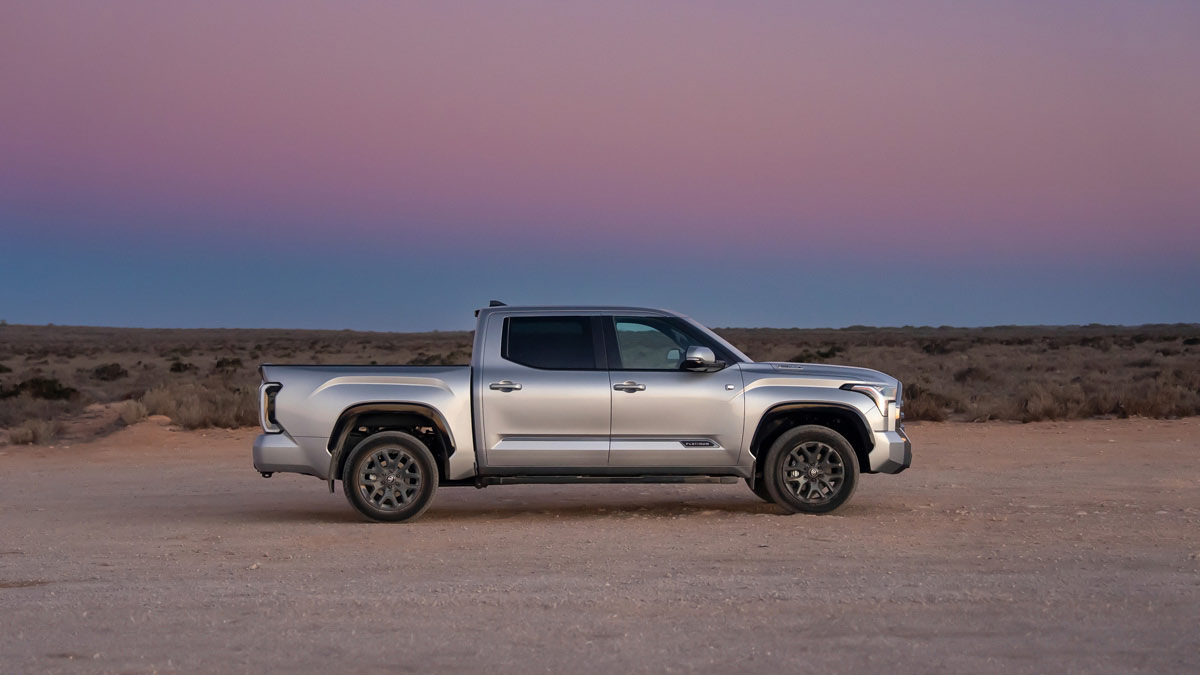
Bold and assertive styling, as well as sheer size, ensure the Toyota Tundra's presence is noticed.
What safety features does the Toyota Tundra Platinum have?
The Toyota Tundra Platinum features a comprehensive suite of advanced safety technologies, including Toyota Safety Sense 2 which includes a pre-collision safety system with day and night detection of pedestrians and oncoming vehicles, as well as daytime cyclist detection.
While Toyota has the largest fleet of connected vehicles in Australia through its Connected Services solution which includes functions such as emergency collision notification (eCall) and breakdown assistance, the tech is not currently available on the Tundra.
Additional standard assistance technologies that are included, however, are emergency steering assist, active cruise control, lane trace assist, lane departure alert and automatic high beam. As we've seen in other Toyota models, the systems are effective but don't annoy with unnecessary or unfathomable chimes and alerts.
Further safety features include a blind-spot monitor and rear cross-traffic alert, front and rear parking sensors, and a panoramic view monitor. This top-spec grade also receives a 10.9-inch head-up display.
The Toyota Tundra is currently unrated by ANCAP but the safety organisation has expressed an interest in assessing full-size pick up trucks and related SUVs in the future.
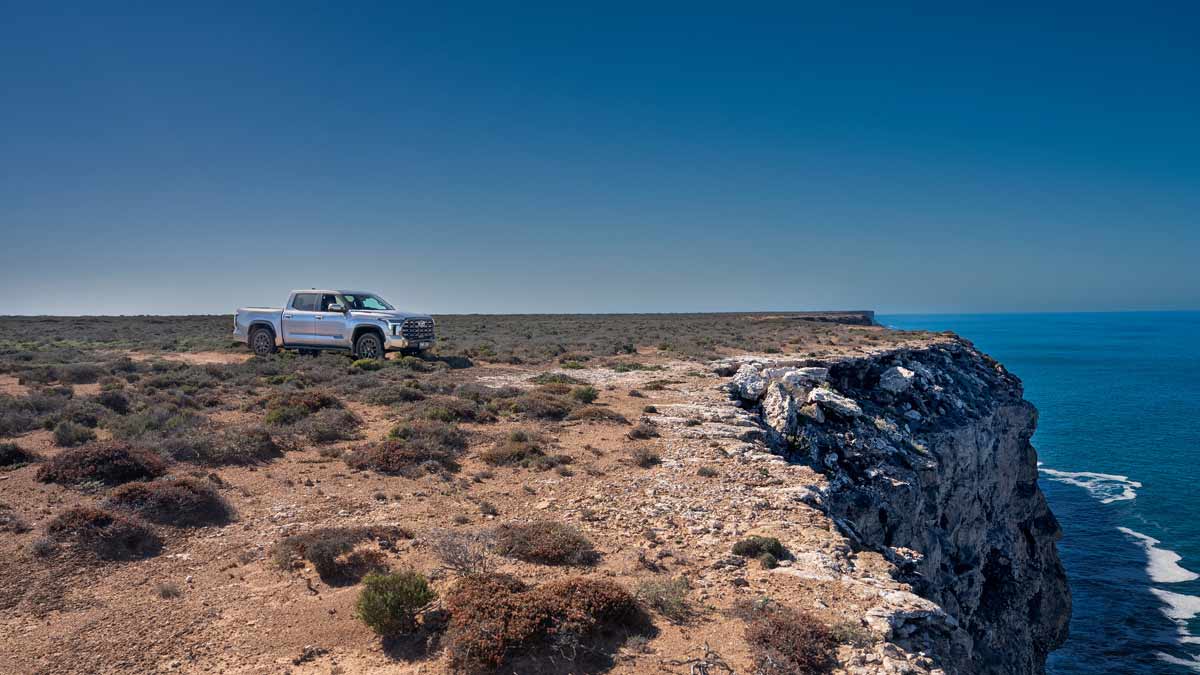
The Toyota Tundra Platinum is not exactly a nimble off-roader, but it does at least feel like it will conquer anything.
How does the Toyota Tundra Platinum compare?
The new 2025 Toyota Tundra Platinum enters the full-size ute fray as the priciest of its cohort – it’s about $30,000 dearer than a Ford F-150 Lariat or Chevrolet Silverado, and around $13,000 above the most expensive Ram 1500. For that premium, the Tundra brings a unique hybrid twin-turbo V6 delivering class-leading power and torque.
On paper, towing capacity is equal. All these American-style trucks can tow up to 4.5 tonnes with the right kit. The Tundra’s beefy construction yields a hefty 2800kg kerb weight, so its payload (758 kg) is slightly lower than rivals (the Ram can carry up to 863kg). Still, performance and hauling capability across the group are broadly comparable in real-world use.
Where Toyota further stands out is with aftersales. It matches Ford with a five-year/unlimited-kilometre warranty and offers better coverage than the three-year/100,000km terms from Ram or Chevrolet. However, maintaining the Tundra may be more demanding: service intervals are every six months/10,000km (twice as frequent as the F-150’s annual visits), translating to higher ongoing servicing needs.
More: Capped Price Servicing Explained
Should I buy a Toyota Tundra Platinum?
Having driven so many electric vehicles and hybrids recently, it’s a philosophical struggle to make a case for large petrol-powered utilities like the Toyota Tundra, albeit one that has an electric motor onboard.
But it appears like they’ve made their own case, reflecting the growing diversity of the vehicles available here in a market which is fragmented and where there's something for every buyer.
The Tundra plays its part in the modern vehicle landscape. Its beefy engine is plenty powerful for overtaking, and once at speed the lofty driving position is comfortable and suitably commanding. Add in features like the powerful massaging mode, which helps to energise the body on longer driving stints, and there’s extra appeal as a road trip companion.
But the Tundra is not perfect for its price and niggles like the issue shifting in and out of four-wheel drive make it less convincing. There are other Toyota utilities, like the HiLux and LandCruiser 70 Series, which offer greater proficiency here.
Its size also goes against it in the urban environment, where it is too big and thirsty to make much sense, particularly if its weekly usage is limited to school runs and other suburban duties.
And then there’s the price. The Tundra Platinum is over $200,000 on-road, so it’s out of reach of most motorists, but it is within reach of a specific subset of buyers, be they tradies, serious lifestyle enthusiasts with boats to tow, or grey nomads heading off on the great Australian lap.
If you’re a buyer looking for a large pick-up truck, you may be considering the Tundra, but crunch the numbers carefully. Does it offer sufficient payload, or might a smaller, lighter, more affordable vehicle serve you better?
The information provided is general advice only. Before making any decisions please consider your own circumstances and the Product Disclosure Statement and Target Market Determinations. For copies, visit racv.com.au. As distributor, RACV Insurance Services Pty Ltd AFS Licence No. 230039 receives commission for each policy sold or renewed. Product(s) issued by Insurance Manufacturers of Australia Pty Ltd ABN 93 004 208 084 AFS Licence No. 227678.


